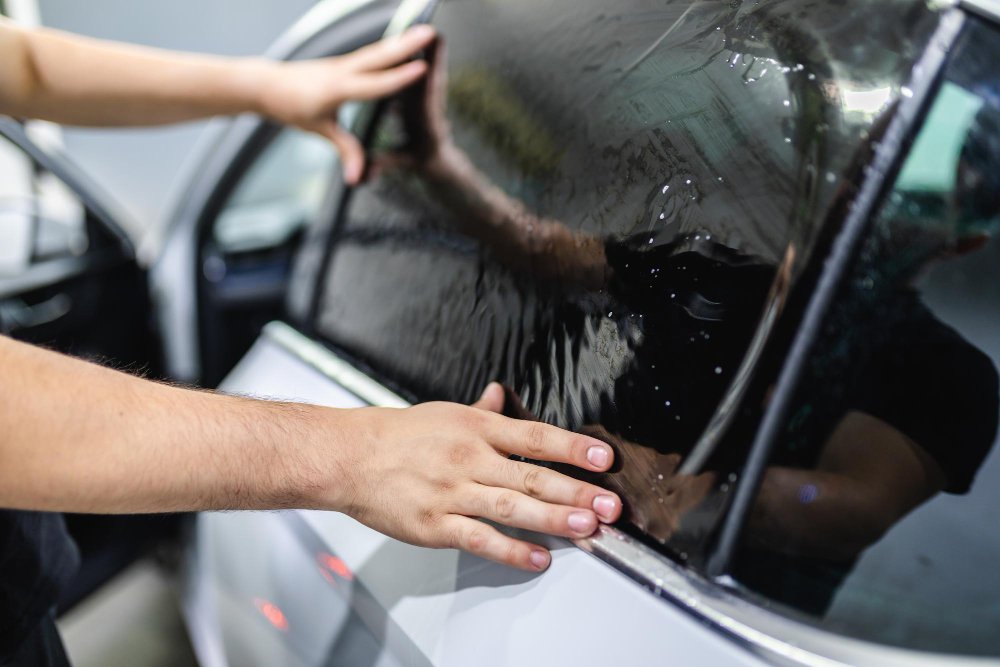How Vehicle Window Tinting Safeguards Your Vehicle's Inside
How Vehicle Window Tinting Safeguards Your Vehicle's Inside
Blog Article
Home Window Tinting Regulations and Standards: What You Need to Know Before Tinting Your Car
Prior to proceeding with window tinting for your vehicle, it is vital to familiarize yourself with the diverse laws and standards that govern this method across various states. These regulations determine the permitted levels of color darkness, typically measured by noticeable light transmission (VLT) percentages, and include details stipulations for front windscreens intended at making sure roadway safety.
Summary of Window Tinting Rules
Window tinting regulations are frequently based on variant throughout various jurisdictions, showing regional guidelines and security factors to consider. These laws determine the permissible levels of tint darkness and reflectiveness on lorry home windows, guaranteeing that vehicle drivers maintain ample presence while also safeguarding versus dangerous UV rays and heat.
A lot of regulations classify window tinting based on the Visible Light Transmission (VLT) percent, which indicates the quantity of light that can travel through the home window. Typically, lower VLT percents signify darker tints. Regulations frequently distinguish between the front, side, and back windows, with stricter constraints applied to the front windshield to improve safety for both the driver and various other road customers.
Conformity with home window tinting policies is vital, as offenses can result in penalties, mandatory elimination of the tint, and prospective boosts in insurance premiums. It is necessary for vehicle proprietors to familiarize themselves with regional laws before continuing with window tinting installations.
State-by-State Color Laws
Comprehending the details home window tinting guidelines in each state is crucial for vehicle proprietors looking for to adhere to the law. Each state in the U.S. has established its own set of rules regulating home window tinting, which can differ significantly. These regulations usually dictate the allowable levels of color darkness, the kinds of windows that can be tinted, and any clinical exceptions that may use.
For instance, states like California have stringent constraints on color darkness for front windows, while others, such as New Mexico, might allow darker tints. Furthermore, certain states mandate particular visibility portions for different windows, including the windshield, front side windows, and back home windows. It is important for automobile owners to acquaint themselves with their state's laws to stay clear of potential fines or penalties.
Furthermore, some states might need a certification sticker to be put on tinted home windows, indicating compliance with state regulations. Failure to adhere to these guidelines not just runs the risk of legal consequences yet can also affect security and presence while driving. Automobile owners should perform comprehensive study or get in touch with regional authorities to make sure full understanding and conformity with state-by-state color guidelines.
Allowed Color Types and levels
Several automobile proprietors may be stunned to learn that permitted tint levels and types differ commonly across various states. Each state has developed its very own guidelines concerning the permitted darkness and reflectivity of home window color, commonly determined by Visible Light Transmission (VLT) percentages. VLT refers to the quantity of light that can go through the tinted home windows; thus, a reduced percent indicates a darker color.

Moreover, the kinds of color materials allowed can vary, with some states forbiding metal or mirror-like surfaces. It is necessary for automobile owners to familiarize themselves with their state's particular regulations to make sure compliance. Non-compliance can lead to penalties, required removal of the color, or various other lawful repercussions, making it important to recognize these policies before waging installment.
Medical Exemptions for Tinting
While not all states give allocations for medical exceptions regarding home window tinting, those that do recognize the requirement for particular people to boost exposure and comfort as a result of medical conditions. Various medical conditions, such as lupus, skin cancer, and certain eye disorders, can provide individuals specifically delicate to sunlight. These individuals may need darker tints to safeguard themselves from dangerous UV rays and glow.

It is vital to note that despite a medical exemption, there might still be limitations on the level of tint enabled. Compliance with state regulations guarantees that people are both secured and within legal restrictions. Those considering medical exceptions ought to contact their local Division of Electric motor Vehicles or comparable authority to understand the demands and treatments needed to apply for an pop over to these guys exemption properly.
Charges for Non-Compliance
Failing to abide by window tinting regulations can cause considerable penalties, which vary by state. Legislation enforcement companies are equipped to release citations for lorries that do not abide by the defined tinting laws. These penalties usually include penalties, which can range from moderate total up to several hundred bucks, depending upon the seriousness of the violation and the state concerned.
In some territories, repeated offenses may cause intensifying penalties or extra penalties, such as mandatory court looks. Non-compliance might require the elimination of prohibited tinting, frequently at the owner's expense. In severe cases, habitual wrongdoers might deal with suspension of their vehicle enrollment until conformity is accomplished.
In addition, insurance effects may occur from receiving multiple citations for window tint infractions. Insurers may see such violations as a sign of riskier actions, possibly causing enhanced premiums or difficulty in coverage.
To stay clear of these fines, it is important for lorry proprietors to acquaint themselves with their regional window tinting laws and ensure that their lorry complies (Window Tinting). This positive technique not just avoids legal implications yet additionally promotes road read the full info here safety and security
Verdict

A lot of laws identify window tinting based on the Visible Light Transmission (VLT) portion, which suggests the quantity of light that can pass via the home window. Conformity with window tinting guidelines is vital, as violations can result in penalties, compulsory elimination of the color, and prospective increases in insurance coverage premiums.Comprehending the details window tinting guidelines in each state is essential for vehicle proprietors looking for to conform with the legislation. These regulations commonly dictate the allowable levels of color darkness, the kinds of home windows that can be tinted, and any type of medical exceptions that might use.
For circumstances, states like California have stringent restrictions on tint darkness for front windows, while others, such as New Mexico, might permit darker tints.
Report this page